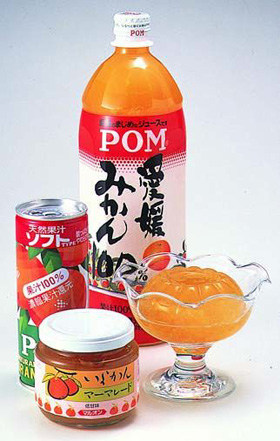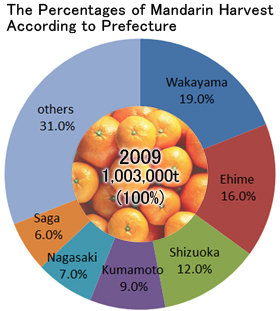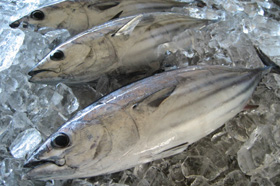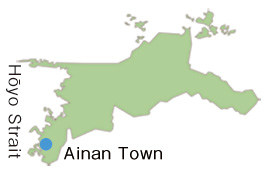本文
The Largest Industry in Shikoku(Agriculture, Forestry and Fisheries Industry)
Agriculture, forestry and fisheries from Ehime, with love

Ehime Prefecture is surrounded by rich and diverse nature; in the south are the Shikoku Mountains, to the north lies the Seto Inland Sea, and to the west is the Uwa Sea. The agriculture, forestry and fisheries industries have developed by taking advantage of the moderate and dry climate. Fruit farming is more popular than rice farming in Ehime because of the geographical and climate conditions; Nanyo (southern Ehime) and islands in the Seto Inland Sea in particular have utilized the steep coastal land, making them into terraced fields for citrus fruits which boast the highest production volume in Japan. At higher elevations, there is dairy and livestock farming, and in the mountainous areas, tomatoes, highland vegetables and tea farming are the major crops. About 70% of Ehime's land is forested, including managed forests of cedar and cypress. Ehime is Japan's largest producer of cypress timber.
The fishery industry in Ehime is blessed with abundant marine resources, and has been developing a coastal fishery and aquaculture. In the Uwa Sea in particular, the industry has made use of the deep coves in the ria shoreline, to support the highest level of aquaculture in Japan. Examples of aquaculture products are pearls and fish.
Other products from the prefecture that have the highest production volumes in Japan include Iyokan oranges, Kiwi fruit, Rye, red sea bream (cultured), and pearls (cultured). Other products that account for a high percentage of total Japanese volume are Mandarin oranges, chestnuts, dried shiitake mushrooms, and yellowtail.
Because of these high production volumes, Ehime Prefecture has a number of products that are well known throughout Japan. To promote Ehime's products further, we have started a campaign using the phrase "Made with Love in Ehime" along with a certification program for "Ehime-brand products that have Love." This is to promote Ehime Prefecture as a preferred area of production for consumers in Japan, as well as overseas, namely Eastern Asian countries such as China. In Ehime, the prefectural government is actively working hand-in-hand with the private sector to expand the market.
|
|
Ehime |
Nationwide |
|---|---|---|
|
Cultivated acreage |
33,705(ha) |
319,137(ha) |
|
Number of fishery management body |
5,009 |
115,196 |
|
Mandarin |
159,400(t) |
1003,000(t) |
|
Kiwi fruit |
9,080(t) |
35,000(t) |
|
Rye |
4,290(t) |
11,200(t) |
|
Chestnut |
2,300(t) |
35,000(t) |
|
Dried shiitake mushrooms |
183(t) |
3597(t) |
|
Forest area |
24,845,302(ha) |
401,117(ha) |
|
Production value of marine culture fisheries |
78,805(t) |
1,202,072(t) |
|
Shima-aji (Yellowtail) (cultured) |
28,682(t) |
154,943(t) |
|
Madai (Red sea bream) (cultured) |
38,731(t) |
70,959(t) |
|
Pearls(cultured) |
7,981(kg) |
22,016(kg) |
|
Hirame (Flounder) (cultured) |
842(t) |
4,654(t) |
Ehime, the Kingdom of Citrus Fruit

Ehime is the top producer of Iyokan oranges and the second producer of Mandarin oranges in Japan.
Ehime Prefecture is one of the foremost citrus fruit producers in Japan and is called the "Kingdom of Citrus Fruit." In recent years, as consumers became more brand-conscious and the competition amongst citrus producers has become stronger, producers in Ehime have introduced leading-edge equipment and technology, such as a photodetector for fruit sorting machines and mulch cultivation, to maintain and to improve the quality of their products.
As well, new crop varieties such as Dekopon, Mari-Hime, Hatsu-Hime, Setoka, Harumi and Beni-Madonna have been developed to keep up with the diversification of consumer's tastes. The citrus juice processing, and canned and jellied citrus fruit industries have also been thriving in Ehime.
An Ehime beverage manufacturer that leads Japan in Mandarin orange juice production has been using world-leading technology to produce fresh and delicious fruit juice.
"Mandarin oranges"

From 1970 to 2003, Ehime was the biggest producer of Mandarin oranges in Japan.
Aquaculture industry that makes use of geographical advantages


In the Nanyo area, Ehime Prefecture has utilized its ria shoreline to develop an aquaculture industry for fish and pearls. This area is a leading producer of aquaculture products in Japan. Red sea bream production is the highest in Japan at more than 40% of production nationwide. Yellowtail production is second highest in Japan. Other cultured species are Japanese horse mackerel, flounder and blowfish. Recently, there is higher demand for supermarkets or overseas markets for processed fish products such as fillets. Moreover, Japanese food as represented by sushi is becoming increasingly popular in Western countries as well as China and Korea. To accommodate these new markets, efforts have been made to actively develop and expand sales in these areas.
Pearl culturing began in 1907 in Hirajo Harbour in Ainan Town and developed as a key industry in the area, reaching the highest production levels throughout Japan in 1974, overtaking the previous leaders of Mie and Nagasaki. Subsequently, because of a massive die-off of oysters, pearl production dropped to 3rd place. However in 2005, production volume returned to 1st place.
Since then, both the prefectural government and the producers have been cooperating to revive pearl production by moving towards production of higher quality pearls through a constant supply of pearl oysters that are resistant to infectious disease but are receptive to piece implantation. Efforts are also being made to increase the brand recognition of Ehime produced pearls.










